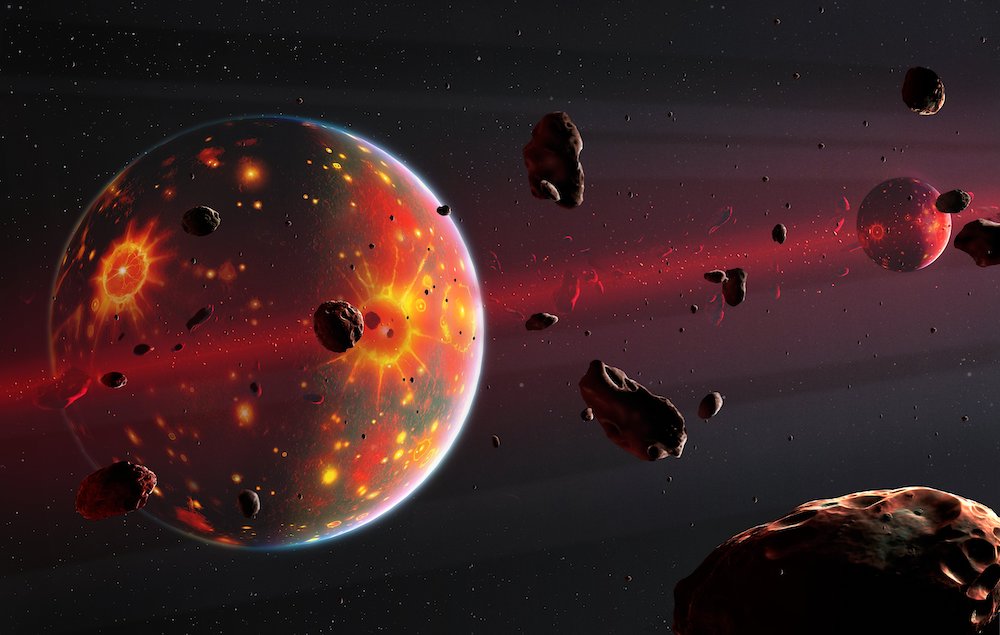Create a free profile to get unlimited access to exclusive videos, sweepstakes, and more!
Apollo rocks reveal the Moon's past was a magnetic game of 'the floor is lava'
We can't decide if 'magnetic floor is lava' sounds like a fun game or not.

The Moon is so close to us, cosmically speaking, that you’d think we’d have a pretty good handle on what’s going on up there. We’ve even touched it, sent our machines chock full of people and instruments to walk around, take in the scenery, and come home with souvenirs. Yet, the Moon remains a mysterious place with all sorts of open questions, many of which date back to its earliest days.
For decades, scientists have been debating the specifics of the Moon’s formation, trying to nail down some of its strangest features. A pair of recently published papers attempts to answer some of those questions, specifically how the Moon developed its magnetic field, and why its crust is the way it is.
When Apollo astronauts went to the Moon in the ‘60s and ‘70s, they brought back samples of the Moon's crust which have garnered decades of research. Investigating those rocks revealed a couple of unusual characteristics. Lunar samples appear to have formed in the presence of a magnetic field substantially stronger than expected, and they are pocked with crystals that just don’t make sense at first glance.
To get to the bottom of this we have to go back to the beginning of the solar system, when the Earth was young, and the Moon didn’t yet exist. The prevailing model of the Moon’s formation proposes a violent collision between two protoplanets shortly after the solar system started coming together. Once the proverbial dust from that collision had settled, the larger mass became the Earth, and the smaller one the Moon.
As a result, the Moon was carrying a whole lot of heat, as is to be expected when you get punched by a planet. According to a paper by Chloé Michaut from the University of Léon and Jerome Neufeld from the University of Cambridge, published in the journal Geophysical Research Letters, after the collision, the Moon was basically one giant global ocean of magma. That magma is what created the crystals, known as anorthosites, seen in the lunar samples.
“We know the samples are anorthosites, and they are typical rocks we find in magma chambers on Earth, so we know they formed in magma,” Michaut told SYFY WIRE.
Previous models of the Moon’s formation suggested that the crystals forming inside the magma must have either sunk to the bottom or risen to the top, leaving the rest to remain in a liquid state. Further examination of the samples, however, revealed that the distribution of anorthosites isn’t segmented in the way we might expect if they were organizing in this way while the Moon was cooling. Instead, they exist throughout the crust.
“Our model proposes that the crystals remained in suspension throughout the entire period of solidification,” Michaut said.
That changes the viscosity of the magma. Instead of comparatively solid layers at the top and bottom with a gooey liquid center, the Moon would have been covered in a global ocean of magma slush. It might have been a sort of thermodynamic opposite of the snow mushing together in the gutter when the temperature picks up during winter.
That process would have taken at least 200 million years to happen, all the while the Moon would have been a very inhospitable place. Moreover, the results tell us something about when the Moon must have formed. The anorthosites date to about 4.3 billion years ago. Add in the few hundred million years for solidification and you find that the Moon must have formed very early in the life of the solar system.
“There are some people who argue that the Moon could have formed later, but if it took 200 to 300 million years to solidify, that’s in agreement with early formation,” Michaut said.
Meanwhile, there’s still the question of the Moon’s magnetic field. Our previous understanding of magnetic fields held a relationship with the size of a world and the size of the field it produces. Strangely, lunar samples show that rocks formed in the presence of a field similar in strength to Earth’s. That shouldn’t be expected for a globe 81 times less massive.
The trick, it turns out, is not to create a consistently strong magnetic field, but to have bursts of magnetic activity during formation. That’s what Alexander Evans from Brown University and Sonia Tikoo from Stanford propose in their recent paper, published in the journal Nature Astronomy.
Magnetic fields are generated through convection of liquid metals in the core. As those metals gyrate in the interior, a magnetic field is formed. Models of the early Moon, however, suggest that it was too small for this sort of action. Additionally, because the surface was also molten, there was nowhere for interior heat to go. No convection, no magnetic field.
Evans and Tikoo suggest that as the global magma ocean cooled, dense metals at the surface would have sunk through the mantle and into the Moon’s core. When these cooler surface metals reached the center it would have been like throwing gas on a fire, driving a burst of core convection and a temporarily strong magnetic field. These chunks of material wouldn’t have all sunk at once. Instead, they would have dropped at intervals, over time, allowing the Moon to have periods of high magnetic fields during the first billion years or so of its existence. Once everything settled, the field disappeared.
This model lets us have our lunar cheesecake and eat it too. We get both a strong magnetic field during crust formation, and no magnetic field today. Mystery solved.
All of which is to say, we might dream of returning to the Moon today, but we’re glad we weren’t around a few billion years ago. The Moon needed time to chill.


























